IKKβ-NF-κB signaling in adult chondrocytes promotes the onset of age-related osteoarthritis in mice
- PMID: 34546791
- PMCID: PMC8734558
- DOI: 10.1126/scisignal.abf3535
IKKβ-NF-κB signaling in adult chondrocytes promotes the onset of age-related osteoarthritis in mice
Erratum in
-
Erratum for the Research Article "IKKβ-NF-κB signaling in adult chondrocytes promotes the onset of age-related osteoarthritis in mice" by S. E. Catheline et al.Sci Signal. 2022 Apr 5;15(728):eabq3030. doi: 10.1126/scisignal.abq3030. Epub 2022 Apr 5. Sci Signal. 2022. PMID: 35380880 No abstract available.
Abstract
Canonical nuclear factor κB (NF-κB) signaling mediated by homo- and heterodimers of the NF-κB subunits p65 (RELA) and p50 (NFKB1) is associated with age-related pathologies and with disease progression in posttraumatic models of osteoarthritis (OA). Here, we established that NF-κB signaling in articular chondrocytes increased with age, concomitant with the onset of spontaneous OA in wild-type mice. Chondrocyte-specific expression of a constitutively active form of inhibitor of κB kinase β (IKKβ) in young adult mice accelerated the onset of the OA-like phenotype observed in aging wild-type mice, including degenerative changes in the articular cartilage, synovium, and menisci. Both in vitro and in vivo, chondrocytes expressing activated IKKβ had a proinflammatory secretory phenotype characterized by markers typically associated with the senescence-associated secretory phenotype (SASP). Expression of these factors was differentially regulated by p65, which contains a transactivation domain, and p50, which does not. Whereas the loss of p65 blocked the induction of genes encoding SASP factors in chondrogenic cells treated with interleukin-1β (IL-1β) in vitro, the loss of p50 enhanced the IL-1β–induced expression of some SASP factors. The loss of p50 further exacerbated cartilage degeneration in mice with chondrocyte-specific IKKβ activation. Overall, our data reveal that IKKβ-mediated activation of p65 can promote OA onset and that p50 may limit cartilage degeneration in settings of joint inflammation including advanced age.
Conflict of interest statement
Figures



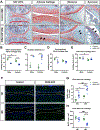

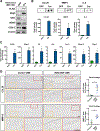
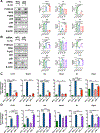
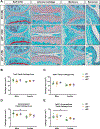
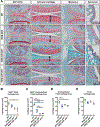
References
-
- Cross M, Smith E, Hoy D, Nolte S, Ackerman I, Fransen M, Bridgett L, Williams S, Guillemin F, Hill CL, Laslett LL, Jones G, Cicuttini F, Osborne R, Vos T, Buchbinder R, Woolf A, March L, The global burden of hip and knee osteoarthritis: estimates from the global burden of disease 2010 study. Ann Rheum Dis 73, 1323–1330 (2014); published online EpubJul (10.1136/annrheumdis-2013-204763). - DOI - PubMed
Publication types
MeSH terms
Substances
Grants and funding
LinkOut - more resources
Full Text Sources
Medical
Molecular Biology Databases
Research Materials
Miscellaneous

